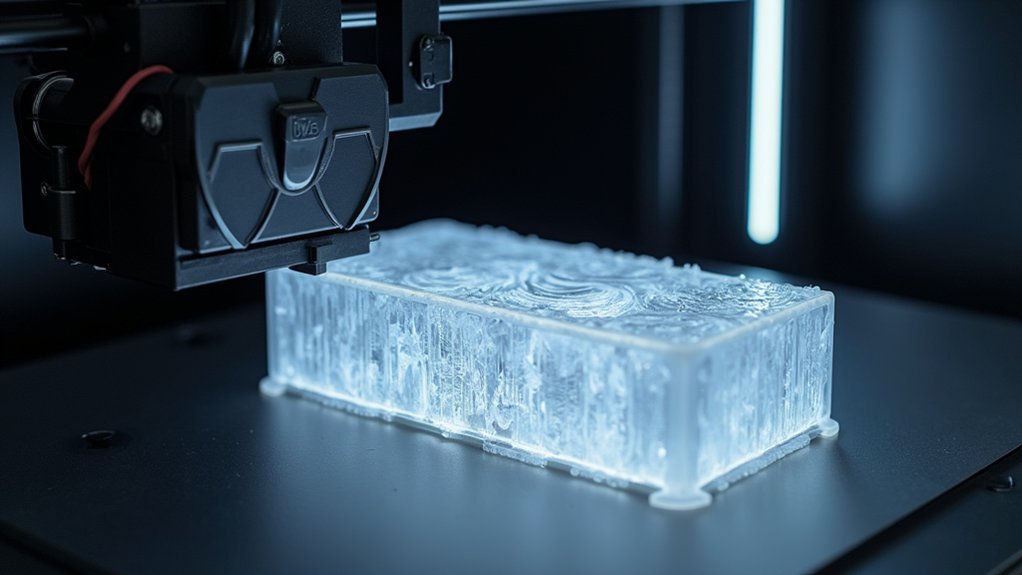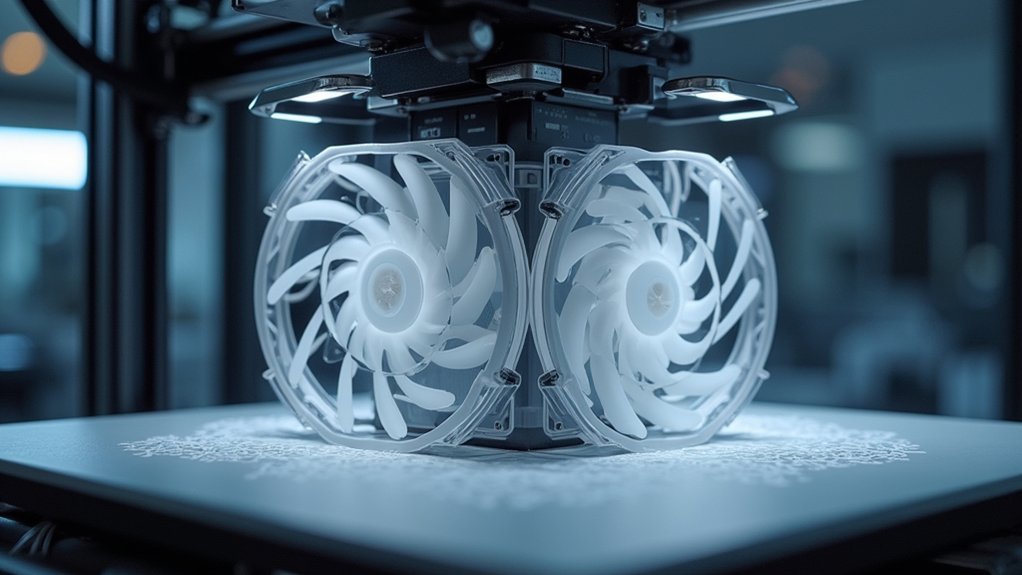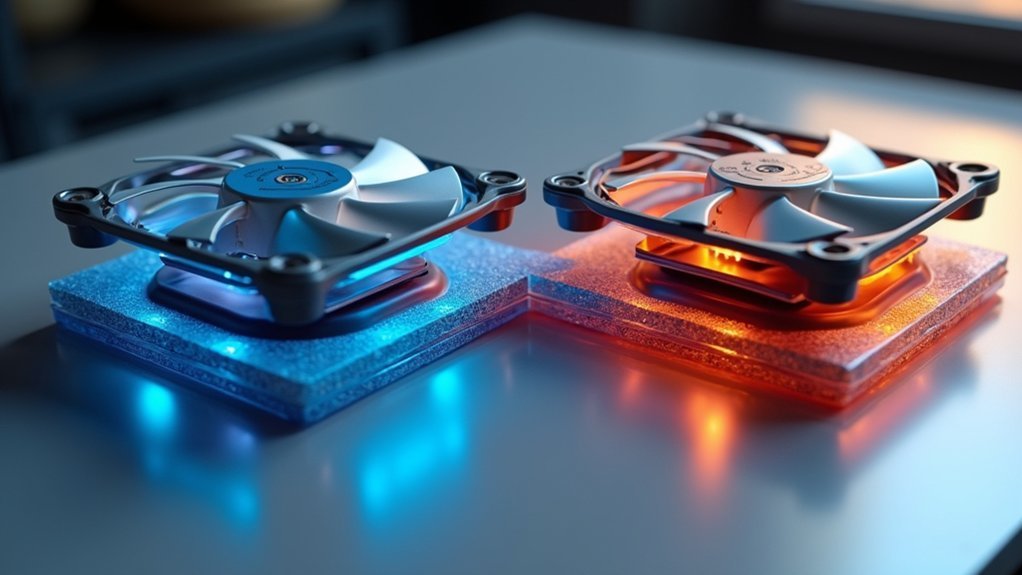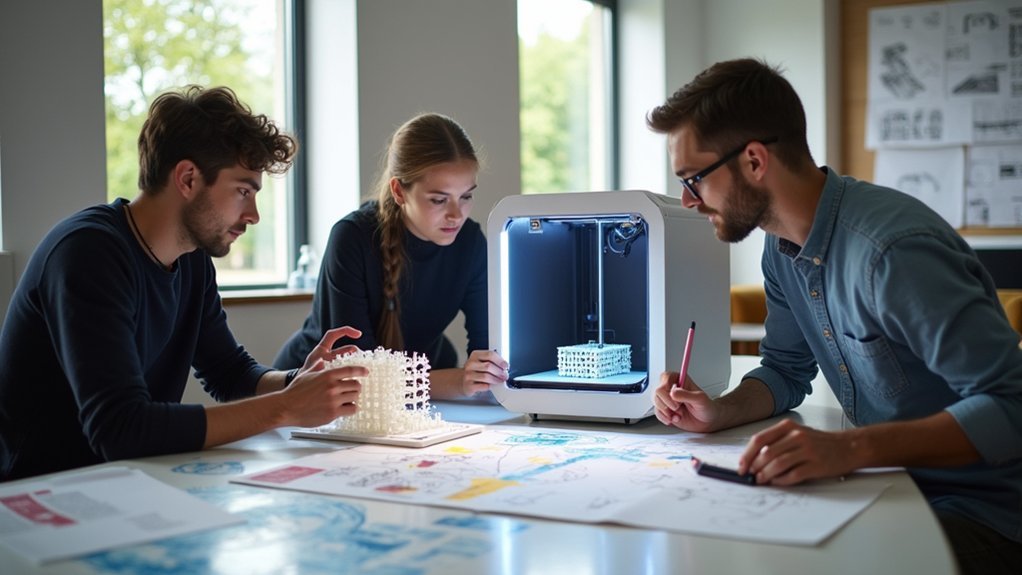You’ll experience dramatically improved print quality with dual cooling fan setups that create superior airflow distribution and eliminate stagnant air pockets. The balanced intake-exhaust configuration reduces layer adhesion issues and warping by up to 20% while maintaining consistent temperatures across your print surface. Complex geometries cool faster with enhanced static pressure reaching tight spaces, and overhangs plus bridges achieve better quality through precise thermal management. Multiple materials benefit from consistent temperature control that our extensive guide explores further.
Enhanced Airflow Distribution Across Print Surface

When you implement a dual cooling fan setup, you’ll immediately notice how it transforms airflow distribution across your print surface.
Enhanced airflow from dual fans creates superior thermal management by establishing consistent circulation patterns that eliminate stagnant air pockets. You’ll achieve better cooling efficiency since one fan handles intake while the other manages exhaust, ensuring thorough coverage.
Dual fans eliminate stagnant air pockets through strategic intake and exhaust positioning, delivering superior thermal management and thorough cooling coverage.
This strategic airflow distribution maintains consistent temperature across your entire print, dramatically improving layer adhesion and overall print quality.
Dual fans effectively combat environmental factors like room temperature variations and humidity fluctuations that typically compromise print reliability.
You’ll find that this setup minimizes dead zones where insufficient airflow previously caused cooling inconsistencies, resulting in more predictable and successful prints every time.
Reduced Layer Adhesion Issues and Warping
This improved airflow distribution directly addresses one of 3D printing’s most persistent challenges: layer adhesion problems and warping.
When you implement a dual fan setup, you’ll eliminate dangerous temperature gradients that cause layers to separate and parts to warp. The enhanced static pressure from two fans delivers uniform airflow across your entire print surface, ensuring consistent cooling throughout the process.
You’ll notice considerably better layer adhesion as the improved cooling rate—up to 20% faster than single-fan configurations—solidifies thermoplastic material more effectively.
This rapid, even cooling prevents the thermal stress that leads to warping, especially on larger prints. The result is dramatically improved print quality with stronger inter-layer bonds and minimal dimensional distortion, making your dual fan investment worthwhile.
Faster Cooling Times for Complex Geometries

Complex geometries with intricate overhangs, bridges, and fine details demand precise cooling control that single fans simply can’t deliver effectively.
When you’re printing these challenging designs, dual fans create optimized airflow patterns that target heat-sensitive areas more efficiently. You’ll achieve faster cooling times because the enhanced static pressure from counter-rotating fans pushes cool air into tight spaces where single fans struggle.
Your dual fan setup prevents localized overheating by maintaining consistent temperatures across complex surfaces. The improved heat dissipation guarantees that delicate features solidify properly without sagging or deformation.
You can expect temperature reductions of 0.5°C to 0.7°C compared to single fan configurations. This effective cooling translates directly into higher print quality for your most demanding complex geometries.
Improved Overhang and Bridge Quality
Although single fans struggle to maintain consistent temperatures across extended surfaces, dual cooling fans deliver superior airflow distribution that dramatically improves overhang and bridge quality.
Dual cooling fans dramatically outperform single fans by delivering superior airflow distribution that eliminates temperature inconsistencies across extended surfaces.
You’ll experience better heat dissipation as dual fans create more uniform cooling across component surfaces, eliminating thermal gradients that cause warping and distortion.
The increased static pressure from dual fans operating together directs airflow more effectively through your cooling system, optimizing cooling efficiency.
When you implement a balanced intake and exhaust configuration, you’ll eliminate hot spots that negatively impact structural integrity.
Testing demonstrates that dual fans achieve temperature reductions of up to 0.7°C compared to single fan setups, ensuring performance stability for your most challenging overhangs and bridges while maintaining consistent quality throughout the cooling process.
Consistent Temperature Control for Multiple Materials

When you’re working with multiple materials that each have distinct thermal requirements, dual fans provide the precise temperature control required to prevent material degradation and maintain ideal performance.
By designating one fan for intake and another for exhaust, you’ll achieve balanced airflow that maintains steady temperatures across different materials in your system.
This configuration enhances cooling efficiency by eliminating thermal hotspots that could compromise sensitive components like CPUs and GPUs.
The combined airflow from dual fans guarantees consistent temperature control, reducing operational temperatures by several degrees compared to single fan setups.
When you properly align and orient both fans, you’ll minimize turbulence while maximizing airflow effectiveness, delivering superior temperature regulation across all heat-sensitive materials in your system.
Frequently Asked Questions
Does Stacking Two Fans Increase Airflow?
Stacking two fans won’t double your airflow. You’ll typically see only a 20% maximum increase, and that’s if you’ve aligned them properly with opposite rotation directions to reduce turbulence.
Does a Cooling Fan Improve Performance?
Yes, you’ll see improved performance with cooling fans. They maintain lower component temperatures, preventing thermal throttling that reduces processing speeds. Better cooling lets your hardware run at ideal frequencies longer, enhancing overall system performance.
Should I Put Two Fans on My CPU Cooler?
You should consider adding two fans if you’re experiencing high CPU temperatures. The push-pull configuration can reduce temps by 0.5-0.7°C, though you’ll see only modest improvements over single-fan setups.
What Are the Benefits of a Cooling Fan?
Cooling fans dissipate heat from your computer components, preventing overheating and thermal throttling. They maintain ideal operating temperatures, extend hardware lifespan, guarantee stable performance, and protect your CPU and GPU from damage.





Leave a Reply